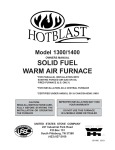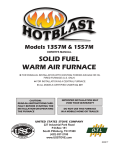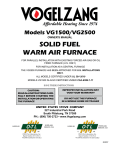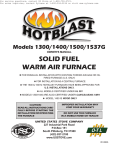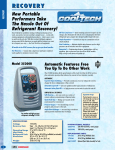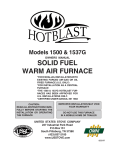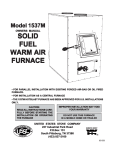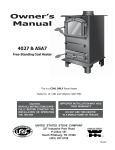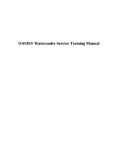Download United States Stove 22AF Owner`s manual
Transcript
Model 22AF OWNER'S MANUAL SOLID FUEL WARM AIR FURNACE *FOR INSTALLATION AS A CENTRAL FURNACE *CERTIFIED UNDER ANSI/UL 391 & CAN/CSA-B366.1-M91 Keeping North America W arm Since 1869 Warm STATES STO TED V NI USSC COMPANY IMPROPER INSTALLATION MAY VOID YOUR WARRANTY DO NOT USE THIS FURNACE IN A MOBILE HOME OR TRAILER UNITED STATES STOVE COMPANY 227 Industrial Park Road P.O.Box 151 South Pittsburg, TN 37380 (423) 837-2100 E U CAUTION: READ ALL INSTRUCTIONS CAREFULLY BEFORE STARTING THE INSTALLATION OR OPERATING THE FURNACE •DRAWINGS FOR ILLUSTRATION PURPOSES ONLY• C R US 851533A 1 CONGRATULATIONS! You've purchased one of America's Finest Wood and Coal Burning Furnaces. By heating with wood and coal you're helping to CONSERVE AMERICA'S ENERGY! Wood is our Renewable Energy Resource. Please do your part to preserve our wood supply. Plant at least one tree each year. Future generations will thank you. NOTE: YOUR UNIT MUST BE INSTALLED BY A QUALIFIED FURNACE INSTALLER. IMPROPER INSTALLATION COULD VOID YOUR WARRANTY! TOOLS AND MATERIALS NEEDED TOOLS MATERIALS Pencil 6 Foot Folding Rule or Tape Tin Snips Drill, Hand or Electric Drill Bit (For Sheet Metal Screws) 1/8" Dia. Screw Driver (Blade-Type) Gloves Sabre Saw 5/16" Nut Driver or 5/16" Socket with Rachet 2 6" Pipe, 6" Elbow, Collar and Thimble; as required (24 gauge min.) 1/2" Sheet Metal Screws 6" Inside Diameter Listed Residential Type or Building Heating Appliance Chimney or Existing Masonry Chimney (SEE Page 8). Electrical Wiring 6" Draft Regulator 1/2" Conduit (Conduit Connectors) Furnace Cement (Manufacturer Recommends: Rutland Black - Code 78 or Equivalent) Plenum and Duct Work as Required •DRAWINGS FOR ILLUSTRATION PURPOSES ONLY• CAUTION Your Furnace has the following labels. Read and obey all labels. DANGER: RISK OF FIRE OR EXPLOSION. DO NOT burn garbage, gasoline, drain oil, or other flammable liquids. WARNING: FIRE HAZARD. DO NOT operate with fire draft exceeding .06 inches W.C. DO NOT operate with fuel loading or ash removal doors open. DO NOT store fuel or other combustible material within the marked installation clearances. DO NOT store fuels, paints, thinners, flammable liquids, or other highly volatile substances in the furnace room. CAUTION: HOT SURFACES Keep children away. Do not touch during operation. WARM-AIR SUPPLY-DUCT SYSTEM MUST BE CONSTRUCTED ONLY OF METAL CAUTION! INSPECT FLUE PIPES, FLUE PIPE JOINTS AND FLUE PIPE SEALS REGULARLY TO ENSURE THAT SMOKE AND FLUE GASES ARE NOT DRAWN INTO, AND CIRCULATED BY, THE AIR CIRCULATION SYSTEM. CAUTION! CLEANOUT OF THE HEAT EXCHANGER, FLUE PIPE, CHIMNEY, AND DRAFT INDUCER IF USED, IS ESPECIALLY IMPORTANT AT THE END OF THE HEATING SEASON TO MINIMIZE CORROSION DURING THE SUMMER MONTHS, CAUSED BY ACCUMULATED ASH. SAFETY NOTICE: If this heater is not properly installed, a house fire may result. For your safety, follow the installation directions. Contact local building or fire officials about restrictions and installation inspection requirements in your area. REFER TO MARKINGS ON THE APPLIANCE FOR ADDITIONAL INFORMATION. •DRAWINGS FOR ILLUSTRATION PURPOSES ONLY• 3 RULES FOR SAFE INSTALLATION AND OPERATION Read these rules and the instructions carefully. Failure to follow them will cause a hazard that could result in death, serious bodily injury, and/or property damage. Check your local codes. This installation must comply with their rulings. 1. 2. Do not install this furnace in a mobile home or trailer. 3. Always connect this furnace to a chimney and vent to the outside. Never vent to another room or inside a building. 4. Do not connect this furnace to an aluminum Type B gas vent. This is not safe and is prohibited by the National Fire Protection Association Code. This furnace requires a masonry or listed factory built chimney for residential type or building heating appliance chimney. Use a 6" diameter chimney or larger, that is high enough to give a good draft. (See Page 8) 5. Be sure that if a masonry chimney is used, it is safely constructed and in good repair. Have the chimney inspected by the Fire Department or an inspector. 6. Inspect chimney connector and chimney before and frequently during the heating season for any deposit of creosote or soot which must be removed (see Chimney Maintenance, page 18.) 7. Provide air for combustion into the room where the furnace is located. If the intake is not in the same room, air must have free access to the room. 8. CAST IRON PARTS MUST BE "SEASONED" TO AVOID CRACKING. BUILD ONLY SMALL FIRES ON FIRST USE. 9. To prevent injury, do not allow anyone to use this furnace who is unfamiliar with the correct operation of the furnace. 10. 11. For further information on using your furnace safely, obtain a copy of the National Fire Protection Association (NFPA) publication "Chimney's, Fireplaces and Solid Fuel Burning Appliances" NFPA 211. The address of the NFPA is Batterymarch Park, Quincy, MA 02269. For more information on Canadian installation , obtain a copy of CAN/CSA-B366-M91 Installation Code for Solid Fuel Burning Appliances and Equipment. 12. Keep the ashpit section free of excess ashes. Do not allow ashes to stack higher than the sides of the ash pan. 13. DISPOSAL OF ASHES - Place ashes in a metal container with a tight fitting lid. Keep the closed container on a noncombustible floor or on the ground, well away from all combustible materials. Keep the ashes in the closed container until all cinders have thoroughly cooled. The ashes may be buried in the ground or picked up by a refuse collector. CAUTION - The special paints used on your furnace may give off some smoke while they are curing during the first few fires. Build small fires at first. The metal used in construction of the furnace and duct work has a light coating of oil. This could give off smoke and/or odors from registers when furnace is used for the first time. This should disappear after a short period of time. Once this burn-off has occurred, it should not reoccur. 4 •DRAWINGS FOR ILLUSTRATION PURPOSES ONLY• RULES FOR SAFE INSTALLATION AND OPERATION 14. CARING FOR PAINTED PARTS - This furnace has a painted outside jacket, which is durable but it will not stand rough handling or abuse. When installing you furnace, use care in handling. Clean with soap and warm water when furnace is not hot. DO NOT use any acids or scouring soap, as these wear and dull the finish. DISCOLORATION WILL OCCUR IF THE FURNACE IS OVERFIRED. FOLLOW OPERATING INSTRUCTIONS CAREFULLY. 15. Keep the feed and ash doors closed at all times except while tending the furnace. Your Furnace is designed to be installed in a parallel air flow arrangement with a gas or oil-fired forced air upflow-type central furnace, or it may be installed as a central furnace. HOW THE FURNACE FUNCTIONS Your Ashley Furnace is designed to be a supplemental or central heating source for your home. This solid fuel furnace may be installed in conjunction with a properly operating central furnace that is listed or certified in accordance with nationally recognized safety standards and equipped with the required controls and other safety features and which has been installed with appropriate standards of National Fire Protection Association with installation clearances specified in the furnace nameplate marking. The installation must be accomplished by a qualified agency (one who is engaged in, and is responsible for, or is thoroughly familiar with the installation and operation of the gas, oil, and solid fuel burning heating appliances, who is experienced in such work, familiar with all precautions required, and has complied with all the requirements of the authority having jurisdiction.) The installation shall be in strict accordance with the manufacturer's installation instructions furnished with the solid fuel furnace. The chimney connector of the furnace is to be installed to provide clearances to combustible material not less than specified in the individual classifications and marked on the furnace. The chimney connector must be connected to a chimney suitable for use with residential type or building heating appliances which burn solid fuel. The furnace is designed to operate in either parallel or series air flow arrangement with the central furnace or as a central furnace. CENTRAL FURNACE INSTALLATION: As a central furnace, the unit functions independently of any other system. The blower will come on when the plenum temperature reaches the setting on the blower control. PARALLEL INSTALLATION: The design is such that when the blower comes on, the blower on the central system also comes on. The blower will only come on when the temperature in the plenum has reached the setting on the blower control. This is to insure that there is sufficient warm air in the system to make it efficient for the unit to operate. When the central system thermostat calls for heat, the central system will operate by the burner igniting and the blower coming on. It is possible that both systems will operate simultaneously. It is recommended that for the most efficient use of your Ashley Furnace, that it be fired as much as possible in order to reduce the demand on your existing central heating system. This unit has an Optional forced draft kit that operates from a wall thermostat. When the temperature falls below the setting on the wall thermostat, the forced draft will come on. (U.S. Stove Option 11 DIK) The warm air supply outlet of the Ashley furnace shall not be connected to the cold air return inlet of the central furnace because the possibility exists of components of the central furnace overheating and causing the central furnace to operate other than is intended. SERIES INSTALLATION: (U.S. & CANADA) This type of installation uses only the blowers of the existing central furnace. The solid fuel fan/limit control must also control the functions of the existing furnace. All electrical power must come from a single branch circuit. •DRAWINGS FOR ILLUSTRATION PURPOSES ONLY• 5 MODEL 22AF DIMENSIONS FIG. 1 6 •DRAWINGS FOR ILLUSTRATION PURPOSES ONLY• LOCATING THE FURNACE 1. The furnace should be located in the same room as the central system and as close as possible, but no closer than 9". There should be no wall between the furnace and the warm air outlet duct that is connected directly to the warm air outlet plenum of the central furnace. See Fig. 2. The unit will require installation with the 2. following clearances: Unit to sidewall ........... 12" (305 mm) Unit to backwall ......... 30" (760 mm) Chimney connector pipe to sidewall .................................. 18" (530 mm) Chimney connector pipe to backwall .................................. 18" (460 mm) Hot air ducts to combustibles .................................. 2" (50 mm) FIG. 2 NOTE: Install only on a noncombustible floor. (REFER TO FIG. 2 & 3) 3. Place the furnace on a noncombustible floor. 4. Check figures 2 and 3. Be sure you have the clearances shown from the furnace and the connector pipe to combustible surfaces. If you have a solid brick or stone wall behind your heater, you can place the furnace as close as you wish to the wall. If the wall is only faced with brick or stone, treat it as a combustible wall. FIG. 3 •DRAWINGS FOR ILLUSTRATION PURPOSES ONLY• 7 CHIMNEY CONNECTION FIG. 4 MASONRY CHIMNEY Before using an existing masonry chimney, clean the chimney and inspect the flue liner to be sure it is safe to use. Make repairs before attaching the furnace. See Page 4, item 5. Look at Fig. 4. The connector pipe and fittings you will need to connect directly to a masonry chimney are shown. The chimney connection should be as short as possible. If the connector pipe must go through a combustible wall before entering the masonry chimney, consult a qualified mason or chimney dealer. The installation must conform to local fire codes, and N.F.P.A. 211. DO NOT CONNECT THIS FURNACE TO A CHIMNEY FLUE SERVING ANOTHER APPLIANCE. The chimney used for a furnace must not be used to ventilate the cellar or basement. If there is a cleanout opening at the base of the chimney, close it tightly. FIG. 5 LISTED FACTORY BUILT CHIMNEY Carefully follow chimney manufacturer's instructions. Use only a Listed Residential Type or Building Heating Appliance Chimney. If your chimney starts at the ceiling (Fig. 5), you will need enough 6" pipe to reach the ceiling. The top of the chimney must be at least 3 feet above the roof and be at least 2 feet higher than any point of the roof within 10 feet (Fig. 5). 8 •DRAWINGS FOR ILLUSTRATION PURPOSES ONLY• RULES FOR CONNECTOR PIPE INSTALLATION 1. The crimped end of the chimney connector fits inside the furnace flue collar. Install additional chimney connector and elbow with the CRIMPED END TOWARD THE FURNACE. This will allow any condensation in the flue to run back into the furnace. Use 6" dia. (minimum 24 gauge) black chimney connector. 2. Slope any horizontal pipe upward toward the chimney at least 1/4 inch for each foot of horizontal run. 3. You must have at least 18 inches of clearance between any horizontal piping and the ceiling. (See Fig. 3) 4. The chimney connector must not extend into the chimney flue (See Fig. 6). 5. Seal each chimney connector pipe joint with furnace cement. Also seal the pipe at the chimney. 6. Use 3 sheet metal screws at each chimney pipe joint to make the piping rigid. 7. The chimney connector may include a section for a barometric draft regulator between the furnace and the chimney (Fig. 4, 5, 6, & 7). The barometric draft regulator must be installed in the same room (same pressure zone) as the furnace. 8. Install the barometric draft regulator strictly in accordance with the instructions that are provided with the barometric draft regulator. A solid damper can be placed between the 9. barometric draft regulator and the chimney. (Fig. 4, 5, 6, & 7) FIG. 6 Adjusting the Barometric Draft Regulator 1. Drill a hole in the chimney connector within 18" of the flue collar below the barometric draft regulator just large enough for the tube of the manometer. 2. Build a fire after all chimney connections have been made. 3. Use a manometer to measure the draft in the flue. (U.S. Stove Model DG-26) 4. Adjust the barometric draft regulator to obtain a draft of 0.05" - 0.06" W.C. under stable conditions. •DRAWINGS FOR ILLUSTRATION PURPOSES ONLY• FIG. 7 9 CONNECTION OF CHIMNEY CONNECTOR TO A MASONRY CHIMNEY THROUGH A COMBUSTIBLE WALL Figure 8 shows how to connect the chimney connector of a heater to a masonry chimney through a combustible wall. There are five allowable ways that a chimney connector can be connected to a masonry chimney by passing through a combustible wall. NFPA Standard 211 allows the following wall pass-through systems. CHIMNEY FLUE FIGURE 8 CONNECTION OF CHIMNEY CONNECTOR TO A MASONRY CHIMNEY THROUGH A COMBUSTIBLE WALL CEILING SEE PARTS A, B, C, D, AND E OF THIS FIGURE FOR OPTIONS. CHIMNEY CONNECTOR MASONRY CHIMNEY CONSTRUCTED TO NFPA 211 TO HEATER COMBUSTIBLE WALL FLOOR PROTECTOR AIRTIGHT CLEANOUT DOOR (FIGURE 8 CONTINUED ON NEXT PAGE) 10 •DRAWINGS FOR ILLUSTRATION PURPOSES ONLY• PART A, FIGURE 8 (FIGURE 8 CONTINUED ON NEXT PAGE) CHIMNEY FLUE MINIMUM 12 IN. TO COMBUSTIBLES MINIMUM CHIMNEY CLEARANCE TO BRICK AND COMBUSTIBLES IS 2 IN. MASONRY CHIMNEY CONSTRUCTED TO NFPA 211 MINIMUM CLEARANCES 12 IN. OF BRICK ALL AROUND CHIMNEY CONNECTOR TO HEATER FIRE CLAY LINER (5/8" MIN. WALL THICKNESS) MIN. 3-1/2" THICK BRICK MASONRY WALL 1. Use a minimum 3-1/2" thick brick masonry wall framed into the combustible wall. A fireclay liner (ASTM C315 or equivalent) having a 5/8" minimum wall thickness must be used and it must be at least 12" away from any material that could catch fire. The inside diameter of the fireclay liner shall be sized for the proper snug fit of a 6" diameter chimney connector pipe. The fireclay liner shall run from the outer surface of the brick wall to, but not beyond, the inner surface of the chimney flue and shall be firmly cemented in place. See Part A of Figure 8. 2. Use a solid insulated listed factory-built chimney length having an inside diameter of 6" and having 1" or more of solid insulation. There must be at least a 9" air space between the outer wall of the chimney length and any combustible materials. The inner end of the chimney length shall be flush with the inside of the masonry chimney flue shall be sealed to the flue and to the brick masonry penetration with nonwater-soluble refractory cement. Sheet steel supports which are at least 24 gauge(0.024") in thickness shall be securely fastened to wall surfaces on all sides. Fasteners between supports and the chimney length shall not penetrate the chimney liner.See Part B of Figure 8. 3. Use a 10" diameter ventilated thimble made of at least 24 gauge(0.024") steel having two 1" air channels. The ventilated thimble must be separated from combustible materials by a minimum of 6" glass fiber insulation. The opening in the combustible wall shall be covered and the thimble supported with sheet steel supports which are at least 24 gauge (0.024") in thickness. The sheet steel supports shall be securely fastened to wall surfaces on all sides and shall be sized to fit and hold the chimney section. Fasteners used to secure chimney sections shall not penetrate chimney flue liner. See Part C of Figure 8. 4. Use an 8" inside diameter solid insulated listed factory-built chimney length which has 1" or more of solid insulation. The minimum length of this chimney section shall be 12" and will serve as a pass-through for the 6" diameter chimney connector. There must be at least a 12" air space between the outer wall of the chimney section and any combustible materials. The chimney section shall be concentric with and spaced 1" away from the chimney connector by means of sheet steel support plates on both ends of the chimney section. The opening in the combustible wall shall be covered and the chimney section supported on both sides with sheet steel supports which are at least 24 gauge (0.024") in thickness. The sheet steel supports shall be securely fastened to wall surfaces on all sides and shall be sized to fit and hold the chimney section. Fasteners used to secure chimney sections shall not penetrate chimney flue liner. See Part C of Figure 8. 5. A listed factory-built wall pass-through system may be purchased and installed according to the instructions packaged with it to provide a safe method of passing the chimney connector through a combustible wall for connection to a masonry chimney. Additional requirements pertaining to Figure 8 and the above wall pass-through systems: 1. Insulation material used as part of wall pass-through system shall be of noncombustible material and shall have a thermal conductivity of 1.0 Btu • in./ft.² • °F (4.88 kg • cal/hr • m² • °C) or less. 2. All clearances and thicknesses are minimums: larger clearances and thickness are acceptable. 3. A chimney thimble, as shown for 3" and 4" above (Parts C and D respectively of Figure 8) shall be for types "3" and 4" connections to facilitate removal of the chimney connector for cleaning. The chimney thimble shall be of ASTM C315 fireclay with 5/8" minimum wall thickness , or material or equivalent durability. The inside diameter of the thimble shall be sized for the proper snug fit of a 6" diameter chimney connector pipe. The thimble shall be installed without damage to the chimney flue. The thimble shall extend through the chimney wall to, but not beyond, the inner surface of the chimney flue and shall be permanently cemented in place with high temperature cement. 4. A chimney connector to a masonry chimney, except for 2" above (Part B of Figure 8), shall extend through the wall pass through system to the inner face of the chimney flue, but not beyond. It does not have to be fastened in place so long as it cannot accidently be pulled out of the chimney or shoved into the chimney flue. If fasteners are used to secure the chimney connector to a masonry chimney, the fasteners shall not penetrate the chimney flue liner. 5. Any material used to close up any opening for the connector shall be noncombustible. •DRAWINGS FOR ILLUSTRATION PURPOSES ONLY• 11 NONSOLUBLE REFACTORY CEMENT AIR SPACE FACTORY-BUILT CHIMNEY LENGTH CHIMNEY FLUE MINIMUM CHIMNEY CLEARANCES FROM MASONRY TO SHEET STEEL SUPPORTS AND COMBUSTIBLES 2 IN. PART B FIGURE 8 (FIGURE 8 CONTINUED) CHIMNEY LENGTH FLUSH WITH INSIDE OF FLUE AIR SPACE 9 IN. MINIMUM MINIMUM CLEARANCE 9 IN. ALL AROUND CHIMNEY CONNECTOR TO HEATER USE CHIMNEY MFRS. PARTS TO ATTACH CONNECTOR SECURELY SOLID INSULATED, LISTED FACTORY-BUILT CHIMNEY LENGTH MASONRY CHIMNEY CONSTRUCTED TO NFPA 211 PART C FIGURE 8 SHEET STEEL SUPPORTS (24 GAUGE MIN. THICKNESS) MINIMUM CHIMNEY CLEARANCES FROM MASONRY TO SHEET STEEL SUPPORTS AND COMBUSTIBLES 2 IN. 24 GAUGE VENTILATED THIMBLE WITH TWO 1 INCH AIR CHANNELS CHIMNEY FLUE CHIMNEY THIMBLE TWO VENTILATED AIR CHANNELS EACH 1 INCH. CONSTRUCTED OF SHEET STEEL. MASONRY CHIMNEY CONSTRUCTED TO NFPA 211 CHIMNEY CONNECTOR TO HEATER MINIMUM 6 IN. GLASS FIBER INSULATION ALL AROUND SHEET STEEL SUPPORTS (24 GAUGE MIN. THICKNESS) MINIMUM CHIMNEY CLEARANCES FROM MASONRY TO SHEET STEEL SUPPORTS AND COMBUSTIBLES 2 IN. PART D FIGURE 8 SHEET STEEL SUPPORTS MINIMUM CLEARANCE 2 IN. ALL AROUND CHIMNEY SECTION 1 IN. AIR SPACE TO CHIMNEY LENGTH CHIMNEY CONNECTOR AIR SPACE 2 IN. CHIMNEY FLUE CHIMNEY THIMBLE MASONRY CHIMNEY CONSTRUCTED TO NFPA 211 CHIMNEY CONNECTOR TO HEATER SOLID INSULATED, LISTED FACTORY-BUILT CHIMNEY LENGTH (12 IN. LONG MIN.) SHEET STEEL SUPPORTS (24 GAUGE MIN. THICKNESS) PART E - (Figure 8) In addition to the methods shown by A, B, C, and D of Figure 8, a listed factory-built wall pass-through system may be purchased and installed according to the instructions packaged with it to provide a safe method of passing chimney connector through a combustible wall for a connection to a masonry chimney. CONNECTION OF CHIMNEY CONNECTOR TO A MASONRY CHIMNEY WHEN CHIMNEY CONNECTOR DOES NOT PASS THROUGH A COMBUSTIBLE WALL If the chimney connector does not have to pass through a combustible wall to get to a masonry chimney, simply connect the chimney connector directly to the masonry chimney's chimney thimble as described and shown by parts C and D of Figure 8. Remember, the chimney connector should extend into the chimney thimble to the innerface of the chimney flue but not beyond; if the chimney connector is extended through the chimney thimble into the chimney flue, resistance to the flow of smoke and gases up the chimney will occur; that flow resistance will have an adverse affect on the operation and performance of the heater and venting system. •DRAWINGS FOR ILLUSTRATION PURPOSES ONLY• 12 BLOWER & COMPONENT ASSEMBLY - FIG. 9 1. Attach the Fan Limit Control Bracket to the rear of the furnace with four(4) of the #10 x 1/2 Tek screws provided in the parts bag. 2. Install the Honeywell Limit Control (1) to the bracket with two(2) of the #10 x 1/2 Tek screws provided in the parts bag. 3. Attach the Junction Box(2) to the Junction Box Bracket using two(2) #10 x 1/2 Tek screws. Then Mount the bracket to the rear of the furnace with four(4) #10 x 1/2 Tek screws. Also Attach the Conduit from the Limit Control to the Junction Box. 4. Install the five(5) Clip Nuts to the back of the furnace. Install the Blower(3) and Blower Gasket(4) to the furnace using the 1/4-20 x 3/4 bolts provided in the parts bag. Attach the remaining piece of Conduit from the junction box to the Blower. Use the Wiring Diagram on the following page to wire the assembly. 5. Reattach the junction box cover. LIMIT CONTROL MOUNTING BRACKET 1 JUNCTION BOX MOUNTING BRACKET CONDUIT 2 CONDUIT CLIP NUTS 3 4 •DRAWINGS FOR ILLUSTRATION PURPOSES ONLY• 13 MODEL 22AF WIRING DIAGRAM - FIG. 11 LOAD FAN LINE LOAD LIMIT BREAK OFF JUMPER FOR LINE LOW VOLTAGE FAN "OFF" INDICATOR (100) LIMIT INDICATOR (200) FAN "ON" INDICATOR (150) Honeywell LIMIT SWITCH R2 R1 WIRE NUTS GROUND G G B B 110 VAC, 60 HZ. WIRE COLOR CODE G - GREEN - GROUND B - BLACK - POWER WIRE COLOR CODE SUPPLY W WHITE -GROUND POWER SUPPLY G--GREENR1 - WHITEPOWER - FAN CONTROL B- BLACKSUPPLY W- -WHITESUPPLY R2 BLACKPOWER - FAN CONTROL R1--WHITECONTROL M1 BLACK FAN - BLOWER MOTOR R2--BLACKCONTROL M2 BLACK -FAN BLOWER MOTOR M1- BLACK- BLOWER MOTOR M2- WHITE- BLOWER MOTOR W W M2 ELECTRICAL JUNCTION BOX M1 BLOWER MOTOR Fig. 10 Fig. 11 IMPORTANT: POWER SUPPLY WIRING MUST NOT BE LESS THAN 90 CENTIGRADE. 14 •DRAWINGS FOR ILLUSTRATION PURPOSES ONLY• INSTALLATION Please see all methods of Installation in Appendix at the rear of this booklet. This is a furnace, not a free standing stove. You must direct heated air from 12" outlet away from the furnace, or it will not function properly. 1. This installation must be done by a qualified heating equipment installer. 2. The installation is to be done in compliance with National Fire Protection Association installation standards: No. 89M, 90B, 211, 70 (National Electric Code) and Uniform Mechanical Code 913, 6-4, in the states where applicable. (Their code offers connecting smoke pipe connectors into chimney with other fuel burning appliances.) 3. Rooms large in comparison with size of the appliances: a) A Wood Burning Furnace needs air for combustion and circulation to house. b) Provision must be made to make up this air and not starve gas or oil furnace of combustion air. c) Have "Authority Having Jurisdiction" determine that air is of adequate makeup. (Reference N.F.P.A. Nos. 30 & 54, Code for Installation of Gas & Oil Equipment) 4. Have "Authority Having Jurisdiction" to inspect all chimneys and installations for adequate venting and for compliance with standard and local codes and regulations regarding installation of wood burning appliances. 5. Installation of Supplemental Heat Application to Existing Central System. (See Fig. 12 for typical installation.) a) Place Wood Burning Furnace so that the chimney connector will be as short as possible and avoiding unnecessary sharp turns in the smoke pipe connector and the installation of devices that would create excessive resistance to the flow of flue gases. b) Locate the Wood Burning Furnace as close as practical to the existing central hot air heating system, maintaining clearances as stated on the label located on the side of the furnace. c) Clearances from combustible materials must be complied with as stated on the label below the fuel door: Unit to Combustible: Front: 48" Back: 30" Sides: 12" Plenum to Ceiling: 2" The installation must be made only on a noncombustible floor. d) Install the smoke pipe connector to the chimney with 26-gauge pipe and elbows (to be purchased separately), maintaining the proper clearances for the specific model. Make sure that the proper clearances as stated on the label and earlier in this manual are maintained. Seal the smoke pipe in the chimney with furnace cement. (The chimney connector shall be securely supported, and joints fastened with sheet metal screws or rivets.) e) Install 8" diameter heat pipe to plenum of the central hot air furnace. Use 26-guage pipe and connectors (to be purchased separately). If central air conditioning is installed in the plenum, install heat pipe above the air conditioning unit. Secure heat pipe connection with supports and sheet metal screws. f) Connect electrical supply in the electrical junction box that is mounted on the back of the Wood Burning Furnace. See Wiring Diagram (Fig. 10). Remove the cover from electrical junction box. Connect power supply wires to wires designated, using wire nuts. The power cord supplied may be used for installation, if permitted by local codes and regulations. If the power cord supplied cannot be used, the power supply wiring must be 90 degrees Centigrade in a metal cable and should be completed by a qualified installer complying with NFPA Standard No. 70 and local codes. Pipe to Combustible: Sides: 18" Back: 18" NOTE: THE MAXIMUM STATIC PRESSURE AT THE CENTRAL OR COMBINED PLENUM MUST NOT EXCEED 0.12 INCHES WATER COLUMN. •DRAWINGS FOR ILLUSTRATION PURPOSES ONLY• 15 (U.S. ONLY) FIG. 11 POWER FAILURE INSTRUCTIONS: Operation after loss of power Remove filter if provided. Do not expect to keep home at normal temperatures. Do not load fuel above bottom of feed door. Set Fuel door and Ash door spin draft maximum closed per the factory installed stops. 1 2 3 4 16 •DRAWINGS FOR ILLUSTRATION PURPOSES ONLY• CENTRAL INSTALLATION (U.S. & CANADA) (FIGURE 12) ADD-ON INSTALLATION (U.S. ONLY) •DRAWINGS FOR ILLUSTRATION PURPOSES ONLY• (FIGURE 13) 17 ALTERNATIVE PARALLEL INSTALLATION WIRING DIAGRAM - FIG. 14 This unit is certified for parallel installation with exitsting forced air-gas or oil fired furnace (U.S. Only) TO GAS/OIL/ELECTRIC TRANSFORMER HOTBLAST COMBINATION CONTROL LIMIT H POWER SUPPLY JUMPER IN H FAN GAS/OIL/ELECTRIC POWER SUPPLY JUNCTION BOX CENTRAL FURNACE BLOWER MOTOR WOOD FURNACE BLOWER MOTOR CAUTION! DO NOT CONNECT PLENUM FAN CONTROL SWITCH ACROSS FURNACE LIMIT CONTROL. 18 •DRAWINGS FOR ILLUSTRATION PURPOSES ONLY• OPERATING INSTRUCTIONS d.Shake grates vigorously 1/2" left to right to spill COAL FUEL ashes into the ash pan. Do this at least once every Egg size (1-3/16" or larger) bituminous coal for residential 12 hours of operation. Empty ash pan regularly. furnaces, or any of the specially packed fireplace coals can be Do not allow ashes to build-up to grate as grate will used. Coal with a low ash content (2% to 6%) is recommended. warp and burnout, and you might spill the ashes WOOD FUEL when removing the pan. Hardwood, 18" to 26" should be split and air dried (seasoned) for Dispose of hot ashes properly (See note 12 on 6 months. page 4). LIGHTING e. Rotation of the handle (5 o'clock to 7 o'clock) Open the draft controls to "HIGH" for maximum draft. 1. position will agitate coals and spill ashes into ash Open the feed door and place paper and kindling on the grate 2. pan. for starting the fire. f. It is advisable for you to get familiar with the shaker Light the fire and close the feed door. 3. grate operation before firing. Add wood or about 15 lbs. of coal (depending on which 4. model) after fire is burning briskly. CAUTION GASES THAT ARE DRIVEN BY FRESH COAL MUST BE Set draft control for desired temperature. BURNED OR THEY WILL ACCUMULATE AND EXPLODE. NEVER SMOTHER A FIRE WHEN ADDING FRESH COAL. ADDING FUEL CAUTION When starting a fire, add small amounts of fuel instead of adding DO NOT OPERATE WITH THE FEED AND/OR ASH DOOR large quantities of fuel. This will give more complete combus- OPEN. THIS FURNACE IS DESIGNED FOR THERMOtion and less build-up of tars or soot in the chimney. STATIC OPERATION. OPERATION WITH ANY OF THESE 1. 2. Set draft control to HIGH before opening feed door. Wood fire Add wood to a convenient level. 3. Coal Fire a. Never smother the fire when adding coal (See Caution). Gas accumulation and a mild smoky explosion will occur. Add fresh kindling if the bed of coals has cooled. b. Add up to 20 lbs. of coal per loading. Never add coal above the bottom of feed door opening. c. Stir the coal and watch the fire. Be sure the new coal is burning briskly before you close the doors and turn the lower the drat control setting down. DOORS OPEN WILL OVERHEAT AND DAMAGE THE FURNACE. CAUTION NEVER USE GASOLINE, GASOLINE-TYPE LANTERN FUEL, KEROSENE, CHARCOAL LIGHTER FLUID, OR FLAMMABLE LIQUIDS TO START OR "FRESHEN UP" A FIRE IN THE FURNACE. CAUTION NEVER STORE FLAMMABLE LIQUIDS, ESPECIALLY GASOLINE, IN THE VICINITY OF THE FURNACE. ADJUSTING BLOWER LIMIT CONTROL SETTINGS The temperature in the plenum of the warm air furnace at which the blower turns on or turns off is controlled by the setting of the pointers in the blower limit control. These pointers may be adjusted through their entire range of settings to achieve the desired warm air output from the furnace. (See Fig. 15) 1. 2. 3. Move both pointers towards the right (counter clockwise) - this increases the temperature setting at which the blower will turn on and off. Move both pointers towards the left (clockwise) - this decreases the temperature setting at which the blower will turn on and off. Move pointers away or apart from each other- this increases the time that the blower will run on each warm cycle. BLOWER FAN "OFF" POINTER BLOWER FAN "ON" POINTER BLOWER LIMIT POINTER AND STOP •DRAWINGS FOR ILLUSTRATION PURPOSES ONLY• FIG. 15 19 SERVICE HINTS Do not expect a furnace to draw. It is the chimney that creates the draft. Smoke spillage into the house or excessive build-up of water or creosote in the chimney would keep it from functioning properly. Correct the problem before using this furnace. Possible causes are: 1. The connector pipe may be pushed into the chimney too far, stopping the draft (Fig. 6). 2. Do not connect two furnaces or a stove and a furnace into the same chimney flue. 3. The chimney used for a furnace must not be used to ventilate the cellar or basement. If there is a cleanout opening at the base of the chimney, it must be closed tightly. 4. If the chimney is operating too cool, water will condense in the chimney and run back into the furnace. Creosote formation will be rapid and may block the chimney. Operate the furnace at a high enough fire to keep the chimney warm preventing this condensation. 5. If the fire burns well but sometimes smokes or burns slowly, it may be caused by the chimney top being lower than another part of the house or a nearby tree. The wind blowing over a house or a tree, falls on top of the chimney like water over a dam, beating down the smoke. The top of the chimney should be at least 3 feet above the roof and be at least 2 feet higher than any point of the roof within 10 feet (Fig. 5). 6. See page 28 for list of trouble shooting tips. A DRAFT READING OF .05 TO .06 W.C. IS SUGGESTED FOR PROPER BURNING OF THIS UNIT WHEN USING WOOD. CHIMNEY MAINTENANCE Creosote and Soot - Formation and Need for Removal When wood is burned slowly, it produces tar and other organic vapors, which combine with expelled moisture to form creosote. The creosote vapors condense in the relatively cool chimney flue of a slow-burning fire. As a result, creosote residue accumulates on the flue lining. When ignited, this creosote makes an extremely hot fire. The chimney should be inspected at least twice monthly during the heating season to determine if a creosote or soot build-up has occurred. 20 If soot or creosote has accumulated, it should be removed to reduce the risk of a chimney fire. Chimney fires burn very hot. If the chimney catches fire, immediately call the fire department, then reduce the fire by closing the inlet air control. Pour a large quantity of coarse salt, baking soda or cool ashes on top of the fire in the firebox. CAUTION A Chimney fire may cause ignition of wall studs or rafters which you thought were a safe distance from the chimney. If you have a chimney fire, have your chimney inspected by a qualified person before using again. •DRAWINGS FOR ILLUSTRATION PURPOSES ONLY• MODEL 22AF - PARTS •DRAWINGS FOR ILLUSTRATION PURPOSES ONLY• 21 MODEL 22AF - PARTS LIST KEY PART NO. 1 69356 2 88032 3 40246 4 25102R 5 22682 6 25106R 7 22761 8 22762 9 24959B 10 25202B 11 23800 12 83445 13 23787 14 83250 15 23397 16 40264 17 89066 18 68238 19 89319 20 22140 21 68234 22 80145 23 68231 24 80131 N/S 80231 25 68232 26 80230 27 40256 28 40257 29 40260 ** 69355 30 25105B N/S 88066 31 83872 32 89354 33 83461 34 24935 35 83045A 36 83274 37 23859B 38 83345 39 83178 * 69388 40 25190B N/S 88033 41 89354 42 ------43 24935 44 83045A 45 83274 46 83503 N/S = Not Shown 22 DESCRIPTION Firebox Weldment Flue Collar Gasket Flue Collar Cabinet Side Cabinet Back Cabinet Top Flue Collar Ring Forced Draft Ring Feed Door Hinge Ash Door Hinge Smoke Curtain 1/4-20 x 1-1/4 Carriage Bolt Smoke Curtain Clip 1/4-20 Kep Nut Baffle Front & Rear Liner Brick (4-1/2 x 9 x 1-1/4 THK.) Ash Pan Weldment Blower Gasket Junction Box Bracket Fan Limit Bracket Assembly Fan Limit Control Fan Limit Conduit Assembly 4 x 4 Junction Box Junction Box Cover Blower Connection Conduit Assembly Blower Motor - 1/20 hp Grate Frame Shaker Grate Shaker Handle Feed Door Assembly (Order ONLY if the entire Assembly is needed) Feed Door (Painted) 5/8 Rope Gasket Door Pin Feed Door Handle Handle Washer Ash Door Latch 3/8" SAE Flat Washer 3/8-16 Lock Nut Spin Damper (Painted) 3/8-16 x 1-3/4 Carriage Bolt 3/8-16 Jam Nut Ash Door Assembly (Order ONLY if the entire Assembly is needed) Ash Door 3/8 Rope Gasket Ash Door Handle Handle Bushings (Comes with Handle - 89354) Ash Door Latch 3/8" SAE Flat Washer 3/8-16 Lock Nut 3/8-16 x 2-1/2 Carriage Bolt •DRAWINGS FOR ILLUSTRATION PURPOSES ONLY• QTY. 1 1 1 2 1 1 1 1 1 1 1 2 2 2 1 2 10 1 1 1 1 1 1 1 1 1 1 1 1 1 1 1 4.58 ft 2 1 1 1 1 1 3 2 4 1 1 2.42 ft 1 1 1 1 1 1 APPENDIX INSTALLATION A NOTE: ANTI-BACKDRAFT FLAPPERS OR BAFFLE ARE REQUIRED FOR THIS INSTALLATION. •DRAWINGS FOR ILLUSTRATION PURPOSES ONLY• 23 APPENDIX INSTALLATION B NOTE: ANTI-BACKDRAFT FLAPPERS OR BAFFLE ARE REQUIRED FOR THIS INSTALLATION. 24 •DRAWINGS FOR ILLUSTRATION PURPOSES ONLY• APPENDIX INSTALLATION C NOTE: ANTI-BACKDRAFT FLAPPERS OR BAFFLE ARE REQUIRED FOR THIS INSTALLATION. •DRAWINGS FOR ILLUSTRATION PURPOSES ONLY• 25 APPENDIX INSTALLATION D (U.S. ONLY) INSTALLATION E (U. S. ONLY) 26 •DRAWINGS FOR ILLUSTRATION PURPOSES ONLY• APPENDIX INSTALLATION F INSTALLATION G •DRAWINGS FOR ILLUSTRATION PURPOSES ONLY• 27 TROUBLE SHOOTING TIPS FOR WARM AIR FURNACE List of Problems 1. Smoking when feed door is open. Possible Cause Solutions a) Insufficient draft. b) Clogged chimney or chimney connector. c) Down draft in chimney. a) Open spin dampers. b) Clean chimney. a) Wood not seasoned and dry. c) Insufficient flue draft. a) Allow wood to season in a dry, well ventilated area for six months. b) Set blower control to higher temperature (See Page 19). c) Set flue draft (See Page 9). 3. Blower does not run. a) Improperly wired. b) Bad blower control. c) Bad relay. d) Bad blower motor. a) b) c) d) 4. No air from registers - fan running. a) Registers are closed. b) Duct work improperly installed. c) Improper wiring between central furnace and Model 22AF. a) Open registers. b) Correct duct work installations. c) Wire unit properly. 5. Air from registers is not hot. a) Blower control set too low. a) Adjust blower control to higher setting (See Page 19). b) Replace blower control. 2. Furnace does not heat. b) Blower control set too low. b) Bad blower control. c) Add raincap to chimney. Wire unit properly. Replace blower control. Replace relay. Replace blower. 6. Blower runs too long. Blower control cut off set too low. Set blower control cut off to higher setting (See Page 19) 7. Blower does not run long enough. a) Blower control cut off set too high. a) Set blower control cut off to lower setting (See Page 19). b) Replace blower. b) Bad blower motor. 8. Smoke and/or odor from registers when furnace is used for first time. Oil from furnace and duct work. The metal used in construction of the furnace and duct work has a light coating of oil. This should disappear after a short period of time. Once this burn-off has occurred, it should not reoccur. 9. Creosote build-up. a) Burning green wood (not seasoned or dry). b) Thermostat setting too low for type fuel. a) Burn only seasoned wood. a) Insufficient draft. b) Smothering fire when adding fresh fuel. a) Open stack damper. b) Add fuel so as not to smother fire. 10. Flame spillage when feed door is open. 28 b) Set thermostat higher to attain higher flue temperatures. This will aid in preventing build-up of creosote. •DRAWINGS FOR ILLUSTRATION PURPOSES ONLY• NOTES •DRAWINGS FOR ILLUSTRATION PURPOSES ONLY• 29 NOTES 30 •DRAWINGS FOR ILLUSTRATION PURPOSES ONLY• HEATING WITH WOOD TYPE WEIGHT PER CORD EFFICIENCY RANKING SPLITS MILLIONS BTU's/CORD (LBS. CU. FT., DRY) Hickory 63 4500 1.0 Well 31.5 White Oak 48 4100 .9 Fair 28.6 Red Oak 46 3900 .8 Fair 27.4 Beech 45 3800 .7 Hard 26.8 Sugar Maple 44 3700 .6 Fair 26.2 Black Oak 43 3700 .6 Fair 25.6 Ash 42 3600 .5 Well 25.0 Yellow Birch 40 3400 .4 Hard 23.8 Red Maple 38 3200 .3 Fair 22.6 Paper Birch 37 3100 .3 Easy 22.1 Elm/Sycamore 34 2900 .2 Very Difficult 20.1 Red Spruce 29 1800 .1 Easy 16.1 •DRAWINGS FOR ILLUSTRATION PURPOSES ONLY• 31 HOW TO ORDER REPAIR PARTS THIS MANUAL WILL HELP YOU OBTAIN EFFICIENT, DEPENDABLE SERVICE FROM YOUR HOTBLAST FURNACE, AND ENABLE YOU TO ORDER REPAIR PARTS CORRECTLY. KEEP THIS MANUAL IN A SAFE PLACE FOR FUTURE REFERENCE. WHEN WRITING, ALWAYS GIVE THE FULL MODEL NUMBER WHICH IS ON THE NAMEPLATE ATTACHED TO THE HEATER. WHEN ORDERING REPAIR PARTS, ALWAYS GIVE THE FOLLOWING INFORMATION AS SHOWN IN THIS LIST: 1. THE PART NUMBER 2. THE PART DESCRIPTION 3. THE MODEL NUMBER: 22AF STATES STO TED V NI USSC COMPANY 32 E U 4. THE SERIAL NUMBER:____________________ UNITED STATES STOVE COMPANY 227 INDUSTRIAL PARK ROAD P.O.BOX 151 SOUTH PITTSBURG, TN 37380 (423) 837-2100 WWW.USSTOVE.COM •DRAWINGS FOR ILLUSTRATION PURPOSES ONLY• C R US
































